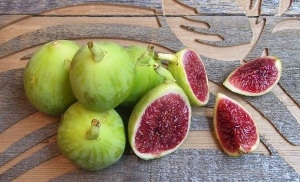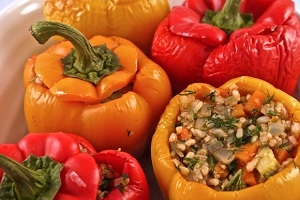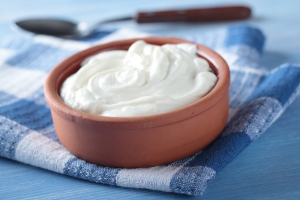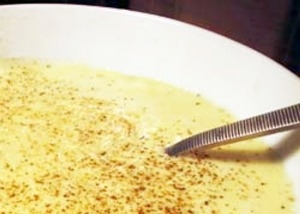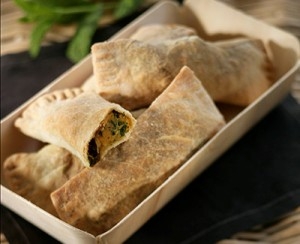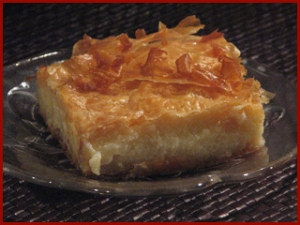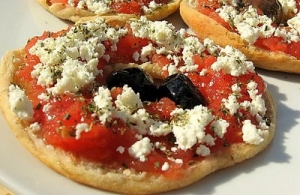ABOUT US
XpatAthens
Savoury Cake With Kasseri Cheese And Herbs
1½ tea-cup of all-purpose flour
4 eggs
2 tea-cups of Greek Kasseri cheese, grated (or mild English yellow cheddar)
4 tbsp of olive oil
1/2 a bunch of fresh spearmint, only the leaves finely chopped (or 1 tbsp of dried, ground)
1 tsp of dried oregano, ground
1 pinch of ground nutmeg
1 pinch of salt
1 pinch of black pepper
5-6 sundried tomatoes, finely chopped (from a jar in oil)
1 sachet of baking powder
100ml of full fat fresh milk
Method:
Preheat the oven to 180° C and place the rack at the lowest position of the oven. Lightly grease the bottom and the sides of a long loaf or cake tin (I prefer the non-stick ones).
In a small bowl mix together the flour with the baking powder.
In a large bowl beat with a whisk the eggs with the milk and the oil until they are well blended. Add the cheese, the herbs, the nutmeg, the tomatoes, salt and pepper and mix well with your hand.
In the end add the flour/baking powder mixture and mix until the ingredients come together. The mixture should be thick, resembling that of a classic sweet cake.
Empty the mixture into the tin and put in the oven. Bake for about 40 minutes. Check the cake out with the classic method of inverting a knife in the middle of it – if it comes out clear and dry then it is ready. Otherwise, bake for a few more minutes and try again.
Take out of the oven and leave the cake to stand in the tin for a few minutes. Turn out onto a plate and serve cut in slices. This type of cake can be served even cold but it is always tastier if it is still lukewarm.
Recipe by Angelos Rentoulas from "Gastronomos" magazine of "KATHIMERINI" newspaper
www.amateurcookprofessionaleater.blogspot.be
Fig-Tastic! The Ancient Fruit In Modern Times
"But how are you even Greek?" is the reaction I always get when I tell people I don't like figs. I know, I know, how am I even Greek when I don't eat the fruit of the gods, the humble fig? So prominent is it in Greek cooking, figs are making a culinary comeback, used more and more not just in sweet dishes but in savoury. And dried, preserved or sweetened they are delectable enough, but just freshly picked off a tree they can reduce grown men to tears - I've seen it with my own eyes.
And no wonder - in Greek mythology figs are associated with Bacchus, also known as Dionysus, the god of wine and song. Yet this very ancient and biblical fruit is making a resurgence in modern times.
A fig tree is said to appear in some images of the Garden of Eden, giving a religious connotation to this Grecian delicacy. Figs are mentioned in the Christian Bible, but not only that, the Muslims' Koran, and the Jewish Torah. The early Greeks so highly prized figs that it was considered an honour to bestow upon the winner of various competitions both the foliage and fruit of a fig tree. And when modesty became popular in ancient times, the private parts of Greek statues were covered with fig leaves. This also comes from the religious belief Adam and Eve covered their nakedness with leaves that are usually said to be from the fig tree after they ate the forbidden fruit. Even some religious scholars believe the forbidden fruit was in fact a fig. Also, in Greek mythology, when Zeus was pursuing Ge and her son, Sykeus, in the war of the Titans, in order to save her son, Ge metamorphosed into a fig tree.
Figs enjoy a Mediterranean climate that has a long, hot, dry summer, that's why they are so commonly found in Greece and Italy and feature heavily in both cuisines. The fig tree can live as long as 100 years and grow to 100 feet tall, although domestic trees are kept pruned to a height of about 16 feet. There are hundreds of varieties of figs, ranging in colour from nearly black to almost white, and only the female fruits are edible. The green varieties are normally reserved for drying.
The shelf life of fresh figs is brief indeed. They must be picked ripe from the trees as they do not ripen well once picked. A very firm fig is not ripe and will not properly ripen further. Snatch them up and use them as soon as you find them in the market as they will spoil within seven to ten days of harvesting. In most cases this means you have about three days at most to use them at home. Select figs that are clean and dry, with smooth, unbroken skin. The fruit should be soft and bouncy to touch, but not mushy and overripe. Use your nose when picking figs and smell the fruit. If it smells slightly sour, it has already begun to ferment. The fruit is sweet to taste and in ancient times, was used a sweetener before refined sugar. And given they are among the richest plant sources of calcium and fibre you can rest assured you are doing your body a good deed by indulging in figs.
But even though there is a short window to indulge in fresh figs, figs as a fruit can be consumed all year round. Dried figs are readily available - and many varieties and brands are imported from Greece to Australia for consumption here. Also, figs can be made into jams, and preserved for savoury dishes or as spoon sweets to enjoy with coffee. There are also biscuits readily available filled with a fig jam. Fresh and dried figs are also perfect for breakfast. Mixed in with Greek yoghurt and honey it makes a nutritious breakfast option. Preserved figs are great to include in muesli and of course, fig jam is perfect on a toasted piece of sourdough.
By Penni Pappas
Fat Free Vegan Greek Rice Stuffed Peppers Recipe
So I have done A LOT of travelling in the past 3 years (visiting over 30 countries around the world), and Greece was one of my favorite places I visited. (And Greek rice stuffed peppers were a favorite I found) Greece was pretty incredible and unexpected as I had never seen anything other than photos of ancient ruins or the white and blue houses of Mykonos on postcards. I went on a 2 1/2 week journey back in August and September of 2010 and visited many different places in Greece.
I saw the ruins of Athens, the rocky shorelines and picturesque houses of Mykonos, the rolling hills and mountains of Naxos, The Palace of the Grand Masters of Knights in Rhodes, the mesmerizing Balos Lagoon and Palace of Knossos on Crete, and the Tholos of Athena Pronaia Sanctuary and Oracle at Delphi.
In my time in Greece I learned that there was much more than just olive oil and seafood to Greek cuisine. Traditionally the Greeks and Cretans ate vegetables, grains, fruits, seafood and olives. In fact their diet was vastly healthier eating homemade unprocessed food, unlike what they do now (which is more like a SAD Westernized diet drenched in copious amounts of olive oil and wine).
So what I took from my travels was using vegetables, grains and herbs in a way that complimented each other to bring out the full flavor of simple vegetable based dishes. The Greek rice stuffed peppers served in Greece are generally stuffed with ground meat as well, but occasionally I found some that were vegan without meat. Mykonos served some at the beach cafes and a Taverna in Delphi had some as well. But these versions used white arborio rice (Italian risotto rice) and were drenched in olive oil.
For my version I decided to switch to whole grain brown rice and remove the olive oil (for health purposes dousing all vegetables in olive oil isn’t recommended). So while it’s not “traditional” it is still very rustic and delicious. I’ve packed it full of dill, parsley and lemon juice so you get all the flavor of the full fat version but without the extra calories.
This recipe is featured in my cookbook Vegan Comfort Foods From Around The World which is available in a digital or physical version wherever you are in the world.
In fact it’s probably my family’s favorite recipe, my mom and even my friends make this recipe regularly as an entree for omnivores and they always receive rave reviews. So it makes me happy that something so simple can be delicious and satisfying to people on a wide variety of diets.
So scroll down for the recipe and get cooking!
Prep Time:
30 min Total Time: 1 hour 20 min
Yield:
Serves 3-4 for entrées or 6-8 as a side dish
Ingredients
6 large or 8 small bell peppers (any color but green)
1 large onion, diced
3 medium carrots, peeled and diced
3 small zucchinis, peeled and diced
1 cup / 236 ml. vegetable broth
3 cups cooked brown rice
5 Tbsp. tomato paste
3/4 cup whole fresh parsley, de-stemmed and chopped
3/4 cup whole fresh dill, de-stemmed and chopped
1/2-1 lemon, juiced
1/4 tsp. fresh ground pepper
3/4 tsp. Herbamare or salt (or to taste)
1 lemon—cut into wedges (optional)
Directions
Preheat oven to 350 F /175 C. Cut tops off of peppers like you would a jack-o-lantern,
remove seeds, and wash thoroughly.
Place in an oven safe dish arranged upright and put tops back on. Bake for 30 minutes.
Meanwhile, in a large pan, saut. onions, carrots and zucchini in vegetable broth for 5-6 minutes.
Stir in the rice and tomato paste and coat thoroughly.
Add parsley, dill, lemon juice, pepper, and Herbamare or salt and stir to combine.
When peppers are ready, remove from oven and fill with stuffing.
Place tops back on peppers and bake for an extra 30-40 minutes until peppers are soft.
Serve additional wedges of lemon if desired.
Additional Tips
Don’t use green peppers. Green peppers are unripe and much harder. They will not be done in time if you cook them along with red, yellow or orange peppers. Additionally you can substitute white rice for the brown if you like.
Nutrition Facts: 6 Servings
Amount Per Serving
- Calories 170.9
- Total Fat 1.4 g
- Saturated Fat 0.3 g
- Sodium 325.7 mg
- Total Carbohydrate 37.1 g
- Dietary Fiber 5.6 g
- Sugars 3.6 g
- Protein 4.4 g
By Low Fat Vegan Chef Veronica
The Dos and Don'ts Of Cooking With Greek Yogurt
Eat it straight or use it to enhance a dish, but learn how to cook with Greek yogurt properly! While we love it straight from under the parchment, cooking with Greek yogurt is another way to incorporate it into your diet. To avoid congealey failure and maximize delicious success, follow these tips.
Don'ts:
• Don't expect it to act just like regular yogurt - chiefly, don't bake with it unless it's thinned out and don't heat it quickly or the concentrated milk proteins will separate from the remainder of the whey, never to unite again. Temper it before adding it to a warm dish, and only then, right at the end.
• Don't try to make it before you've mastered regular yogurt, straining three times requires more effort and planning than you might think. Cool tip: big coffee filters.
Do's:
• Do substitute Greek yogurt for buttermilk or heavy cream, two things you might not readily have in your fridge (who has buttermilk in their fridge?) Just water it down slightly to match the consistency.
• Do put it in your ice cream maker, it freezes faster and creamier than regular yogurt. Plus the healthy bacteria will even survive a freezing!
To read more, please visit foodrepublic.com
Author: Jess Kapadia
Diples Recipe
Made with some ladies at Penelope’s house in Stoupa, diples are made in very large quantities in Greece and offered at celebrations: weddings, baptisms, the opening of a new shop or moving house. Women always work in groups when they can be making upward of 300 or more. They also keep in an airtight container for months!
Ingredients
3 eggs
55 g (¼ cup) sugar
300 g (2 cups) plain flour
1 tbsp oil, to oil hands
extra virgin olive oil, for frying
Syrup
350 g (1 cup) honey
220 g (1 cup) sugar
3 tsp orange juice
125 ml (½ cup) water
½ cinnamon stick
2 cloves
To serve
ground walnuts
sugared almonds
edible flowers
ground cinnamon
Instructions
Resting time: 30 minutes
Whisk the eggs vigorously until pale. Add sugar and continue whisking until the sugar is dissolved. Slowly add the flour, whisking constantly, until a dough forms. Oil your hands and knead the dough until smooth. Wrap in plastic wrap and rest for 30 minutes.
Divide the dough in half. Roll each half until thin or else use a pasta machine. To test if it is thin enough, when you lift a corner of the dough and gently blow under it, it should lift. Using a serrated pastry cutter, cut the dough into 8 cm x 10 cm strips. Pinch the two sides of each strip together at 2-3 cm intervals and pull into circles, squeezing together to make firm. They will look like frilly rosettes. A much simpler way is to roll the dough out the width of a pasta machine (approx. 13 cm) and then cut into lengths of around 12 cm.
Heat extra virgin olive oil in a large, wide frying pan to a depth of 7 cm. Drop the prepared rosette diples in the pan a couple at a time and cook until a gentle golden colour, rolling over to cook both sides. If you are using the flat shapes, hold one edge with tongs and place in the hot oil. As they start to puff, roll into cylinder shapes. This can be done with another pair of tongs or in Greece they use a long carving fork and a spatula. Drain on paper towel.
Place syrup ingredients in a large saucepan and cook over low heat until hot. Dip the diples in hot syrup, making sure they are completely coated. Drain.
Serve diples decorated with ground walnuts, sugared almonds and edible flower petals, dusted with cinnamon.
Cook's notes
Oven temperatures are for conventional; if using fan-forced (convection), reduce the temperature by 20˚C. | We use Australian tablespoons and cups: 1 teaspoon equals 5 ml; 1 tablespoon equals 20 ml; 1 cup equals 250 ml. | All herbs are fresh (unless specified) and cups are lightly packed. | All vegetables are medium size and peeled, unless specified. | All eggs are 55-60 g, unless specified.
By Lyndey Milan
Dinner Tonight: Avgolemono
With some chicken stock in the freezer and a pile of lemons, I set out to see what the hype was about (this recent cloudy weather made it all the more appealing). Some orzo or rice is simmered in the stock until tender, and in the meantime the egg whites are whipped separately, the yolks and lemon juice added, followed by some of the warmed stock.
By throwing the whisk around like a madman, I was able to achieve the soup's unique alchemy: the eggs, rather than stiffening and cooking into a scramble-like mess, turn the soup creamy and rich. It also softens the acidity of the lemon, which leads off the flavor profile, followed by "richness of eggs, salt of chicken [stock], and starch of rice, in that order." This one's going in my regular Winter rotation.
Ingredients
8 cups chicken stock, preferably homemade, if not, low sodium
1 cup orzo pasta, or rice
4 eggs, separated
Juice of 3 lemons
Freshly ground black pepper
Procedure
1 Bring stock to a boil and add orzo or rice. Simmer until tender, about 20 minutes. Season stock to taste with salt, if necessary.
2 When the orzo or rice is nearing tenderness, whisk the egg whites in a separate bowl until medium peaks. Add egg yolks and lemon juice, whisking continuously.
3 When the orzo or rice is finished, transfer 2 cups of the hot stock to the egg/lemon mixture, adding very slowly in a constant stream and beating vigorously to prevent the eggs from solidifying.
4 Take the soup off the heat and add the beaten mixture back into the pot, whisking to incorporate. Serve immediately with freshly ground black pepper.
To read more please visit seriouseats.com
Traditional Pies From Ikaria (Pitarakia)
These traditional pies, so called "poor", are in fact full of flavor and exceptionally healthy. They are one of the most popular, traditional foods of Ikaria.
For the dough
4 1/2 cups flour
1 scant tsp salt
4 tbsp olive oil
1 tbsp vinegar
300 gr. water
For the filling
1 pumpkin, about 1 ½ kg, peeled and diced
4 onions, chopped
½ cup olive oil
1 bunch of fennel, chopped
1 bunch of mint, chopped
1 cup of fresh oregano, chopped
Salt and pepper
Prepare the dough
1. In a bowl or mixer bowl, combine the flour with the salt. Then, add the oil, the vinegar, and the water. Mix until the ingredients are very well combined.
2. Knead the dough for about 10 minutes, adding flour or water until the dough is smooth and not sticky. Cover the bowl with plastic wrap and set aside for at least one hour before using it.
Prepare the filling
1. Preheat the oven to 180°C.
2. Place the pumpkin in a shallow baking pan, lined with parchment paper. Bake for 20 - 25 minutes until softened and all liquids are absorbed.
3. Cook the onion in a large, heavy, dry saucepan, over low heat, for 8-10 minutes, without adding any oil, until it produces its own liquid and gets softened.
4. Add the oil and turn off the heat.
5. Transfer the pumpkin to the saucepan with the onion. Add salt, pepper and the herbs. Stir and set the mixture aside to cool.
Prepare the pies
1. Divide the dough into 4-5 equal balls. Flatten a bit with the palms of your hands. Then, flour a working surface and roll them out to thin sheets.
2. Cut into squares, fill each square with about 1 tbsp filling, wrap the sheet so as to form oblong rolls, and place in oiled baking pan.
3. Bake in the oven for about 12-15 minutes or until golden colored.
Serve warm, at room temperature.
greek food - greek cooking - greek recipes by diane kochilas http://www.dianekochilas.com/
Galaktoboureko - Custard Pie With Phyllo Recipe
This custard pie is my absolute favorite Greek dessert. If you can get past the tongue twister name, Galaktoboureko (gah-lahk-toh-BOO-reh-koh) can easily become your favorite Greek pastry as well. It’s a divine combination of creamy custard and flaky phyllo dough that is baked to golden perfection then drenched with a lemon and orange infused syrup.
The only caveat is that this dessert is best served the same day it is made. Once refrigerated, the custard tends to harden and loses its lovely texture.
Ingredients
For the filling:
• 6 cups milk
• 1-1/4 cup fine flour
• 6 egg yolks
• 1/2 cup sugar
• 1 tbsp. vanilla extract
• 2 tbsp. unsalted butter
For the syrup:
• 1 cup sugar
• 1 cup water
• 5 cm piece of lemon rind
• 5 cm piece of orange rind
• Juice of 1/2 a lemon
• ½ kilo phyllo pastry sheets
• ½ kilo unsalted butter, melted (for brushing)
Preparation:
Make the Filling: In a large saucepan, heat the milk over medium high heat until just boiling. Add the flour and stir with a whisk. Lower the heat to medium low.
Using a whisk, beat the egg yolks with the sugar. Ladle a cup of the warmed milk into the egg mixture to temper and then add the egg yolk mixture to the pot.
Continue to cook over medium low heat until the cream starts to thicken, stirring continuously.
When the custard has thickened, remove from heat and stir in the vanilla extract and the butter. Set aside.
Unwrap the Phyllo: Carefully remove the Phyllo roll from the plastic sleeve. Using a pair of scissors or sharp knife, cut the sheets in half to make two stacks. To prevent drying, cover one stack with wax paper and a damp paper towel while working with the other.
Preheat the oven to 350 degrees.
Assemble the Galaktoboureko: Using a pastry brush, brush the bottom and sides of a rectangular pan. You will use approximately half the phyllo sheets for the bottom of the pastry. Begin by layering sheets one by one in the bottom of the pan, making sure to brush each one thoroughly with melted butter.
When you have almost layered half the sheets, drape two sheets of phyllo so that they extend half in the pan and half out of the pan horizontally. Add the custard in an even layer on top of the sheets, smoothing the surface with a spatula. Fold the phyllo sheet flaps in over the custard layer. Add the remaining sheets on top, brushing each sheet with melted butter.
Before baking, score the top layer of phyllo (making sure not to puncture the filling layer) to enable easier cutting of pieces later. I place the pan in the freezer for about 10 to 15 minutes to harden the top layers and then use a serrated knife.
Bake in a preheated oven for 45 minutes or until the phyllo turns a deep golden color.
While the Galaktoboureko is baking, prepare the syrup: Combine the sugar and water in a saucepan and add the lemon peel and orange peel. Boil over medium high heat for approximately 10 – 15 minutes. Remove the lemon and orange peel and stir in the lemon juice. Remove from heat and set aside to cool.
Prep Time: 45 minutes, Cook Time: 45 minutes
Total Time: 1 hour, 30 minutes, Yield: Approximately 24 pieces
Caution: Do not pour hot syrup over the hot custard. Allow both to cool to room temperature and then carefully ladle the syrup over the galaktoboureko and allow time for it to be absorbed.
To read more, please visit greekfoodabout.com
Dakos Delicious
Dakos, whether you eat it for breakfast, lunch or as a snack any time of the day, it is always wholesome and filling. To make dákos you start with bread rusks. We like the traditional barley krithári or wholemeal olikís alésios rusks with their chunky texture and wholesome flavour. The word ντάκος comes from the way the bread is prepared. This is slicing the bread loaf three quarters of the way through and then baking. Bread rusks paximádia are enjoyed throughout Greece.
Traditionally in Greece paximádia are made by cutting slices from a loaf of fresh home-made bread and then baking them again in the oven till crunchy.
As you can see dako and paximádia are very similar, the difference being how they are cut before they are cooked.
Drizzle a little water on the rusks to soften, then pore plenty of Cretan olive oil over them. Grate fresh garden tomatoes directly onto the rusks and add onion rings.
To read more, please visit we-love-crete.com
Fassolada-Greek Bean Soup
This is such a Greek food staple and yet one can never eat it at a Greek restaurant in Greece, unless it is a taverna somewhere up in the mountains where soups and stews are available to the weary travellers. There is nothing exceptional about the recipe as far as the ingredients go: beans, onion, celery, tomato, carrots, olive oil. That’s it.
Yet again, this is one of those foods that are perfect for cold weather, warm and comforting and most importantly highly nutritious. In my family we ate it together with: feta cheese, black Kalamata olives, smoked mackerel dressed in olive oil and lemon, and of course loads of bread, so it became a full meal.
If you want something less rustic, you can whizz everything in the blender and serve it as a veloute with croutons or even crispy bacon.
INGREDIENTS for 4-6 people
500gr dry white beans, soaked
2-3 carrots, sliced
1 onion, sliced
half bunch of celery, chopped
1 400g can of chopped tomatoes
1 clove garlic (optional)
olive oil
salt, pepper
DIRECTIONS
Soak the beans in warm water with a bit of salt for at least 8 hours. Drain, rinse and fill the pan again with fresh water. Bring to the boil and skim the froth.
Add all the ingredients: carrots, celery, onion, tomatoes, garlic if you are using and 1-2 tbsp of olive oil.
Boil until tender, about two hours. The fresher the beans the quicker they boil. You can also use a pressure cooker if you are really in a hurry. It will only take 10 minutes.
When the beans are ready, season well with salt and pepper. The soup should be thick and creamy. This usally occurs naturally due to the starch contained in the beans. If, however your soup turns out watery, you can easily thicken it by dissolving one tbsp of flour and letting it boil for one minute.
Serve hot with some extra pepper and olive oil on top.
KALI OREKSI!


